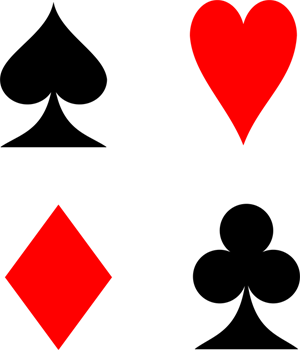
PUMPA - SMART LEARNING
எங்கள் ஆசிரியர்களுடன் 1-ஆன்-1 ஆலோசனை நேரத்தைப் பெறுங்கள். டாப்பர் ஆவதற்கு நாங்கள் பயிற்சி அளிப்போம்
Book Free DemoProbability of an event
The mathematical expression or the formula to represent the probability of an event is given by:
\(\text{Probability of an event} = \frac{\text{Number of favourable outcomes}}{\text{Total number of possible outcomes}}\)
Example:
In a deck of cards, there are \(52\) cards in a deck which comprises of \(13\) spade cards, \(13\) clover cards, \(13\) heart cards and \(13\) diamond cards.

Every category of \(13\) cards composes of a king, a queen, a jack, an ace and cards numbered from \(2\) to \(10\)
The spade and the clover are black cards and the heart and the diamond are red cards.
Hence, there are totally \(13 + 13 = 26\) black cards.
Similarly, there are totally \(13 + 13 = 26\) red cards.
The chance of drawing each card from the deck is equally likely.
Let's find the probability of some events dealing with deck of cards.
Find the probability of drawing the following cards from a deck.
(i) an ace
(ii) a king
(iii) a red card
(iv) a number \(7\)
Solution:
(i) Let \(A\) be the event of drawing an ace from a deck of cards.
The number of favourable outcomes \(=\) \(4\).
The number of possible outcomes \(=\) \(52\).
Therefore, the probability of drawing an ace from a deck of cards \(P(A)\) is computed using the probability formula as follows:
\(P(A) = \frac{4}{52}\)
\(=\) \(\frac{1}{13}\)
(ii) Let \(B\) be the event of drawing a king from a deck of cards.
The number of favourable outcomes \(=\) \(4\).
The number of possible outcomes \(=\) \(52\).
Therefore, the probability of drawing a king from a deck of cards \(P(B)\) is computed using the probability formula as follows:
\(P(B) = \frac{4}{52}\)
\(=\) \(\frac{1}{13}\)
(iii) Let \(C\) be the event of drawing a red card from a deck of cards.
The number of favourable outcomes \(=\) \(26\).
The number of possible outcomes \(=\) \(52\).
Therefore, the probability of drawing a red card from a deck of cards \(P(C)\) is computed using the probability formula as follows:
\(P(A) = \frac{26}{52}\)
\(=\) \(\frac{1}{2}\)
(iv) Let \(D\) be the event of drawing a number \(7\) from a deck of cards.
The number of favourable outcomes \(=\) \(4\).
The number of possible outcomes \(=\) \(52\).
Therefore, the probability of drawing a number \(7\) from a deck of cards \(P(A)\) is computed using the probability formula as follows:
\(P(D) = \frac{4}{52}\)
\(=\) \(\frac{1}{13}\)
Reference:
Icons of cards: https://pixabay.com/vectors/playing-cards-cards-suit-spades-2091948/